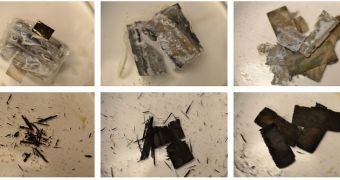Often, things are built to last. Other times, humankind bemoans the distinct lack of mechanical, electrical and chemical contraptions that just won't decompose. Scientists are working on it though, and apparently making progress.
There still isn't any device that will fully disperse into its constituent parts in a landfill environment, not in less than a century or millennium anyhow.
That length of time doesn't really define something as biodegradable though. To qualify, an object or substance must be able to dissolve in a matter of months or weeks.
Apparently, researchers from the University of Illinois at Urbana-Champaign, led by one John Rogers, were able to invent a battery that decomposes in 3 weeks.
It's a pretty small thing, granted, measuring a single square-centimeter, but it's still a working battery made of metals.
Inside it are an anode, 50 micrometers thick, and a cathode, 8 micrometers thick. The current produced is of 2.4 milliamps, not exactly massive but enough to power tiny things.
Magnesium foil was used to make the anode, while iron, molybdenum or tungsten can be employed for the cathode.
All these biocompatible materials can dissolve in water over a period of 21 days. That means that it will take a while longer in soil, but that rain will do away with the remnant eventually if, say, you switch out the battery in your wrist watch and throw it away during a hike on the mountains.
By the time the dissolution is complete, only 9 milligrams of magnesium are left, less than that really, which is the same as a magnesium coronary artery stent successfully tested in clinical trials.
In layman terms, that means that the battery could be used in biodegradable implants of monitoring probes, provided said implants and/or probes are just as biodegradable as it is.
The researchers might have to figure out how to reduce the leftover magnesium, or whatever else, before that idea comes to fruition, because a little magnesium here with a bit of iron or whatever else from the rest of the implant will pile up. The 9 milligrams from the battery may be harmless, but not if a bunch of other stuff is added from the rest of the tiny device.
Until then, environment monitoring is a significantly more approachable field, like, say, monitoring an ocean after oil spills or stuff along those lines.
On that note, from now on, the scientists will be focusing on creating biodegradable devices and figuring out how to invent the soluble Wi-Fi chips needed for implants to make do without wires of skin ports, or for a swarm of tiny monitoring bots or sensors to be of any use in the vastness of the sea.

 14 DAY TRIAL //
14 DAY TRIAL //